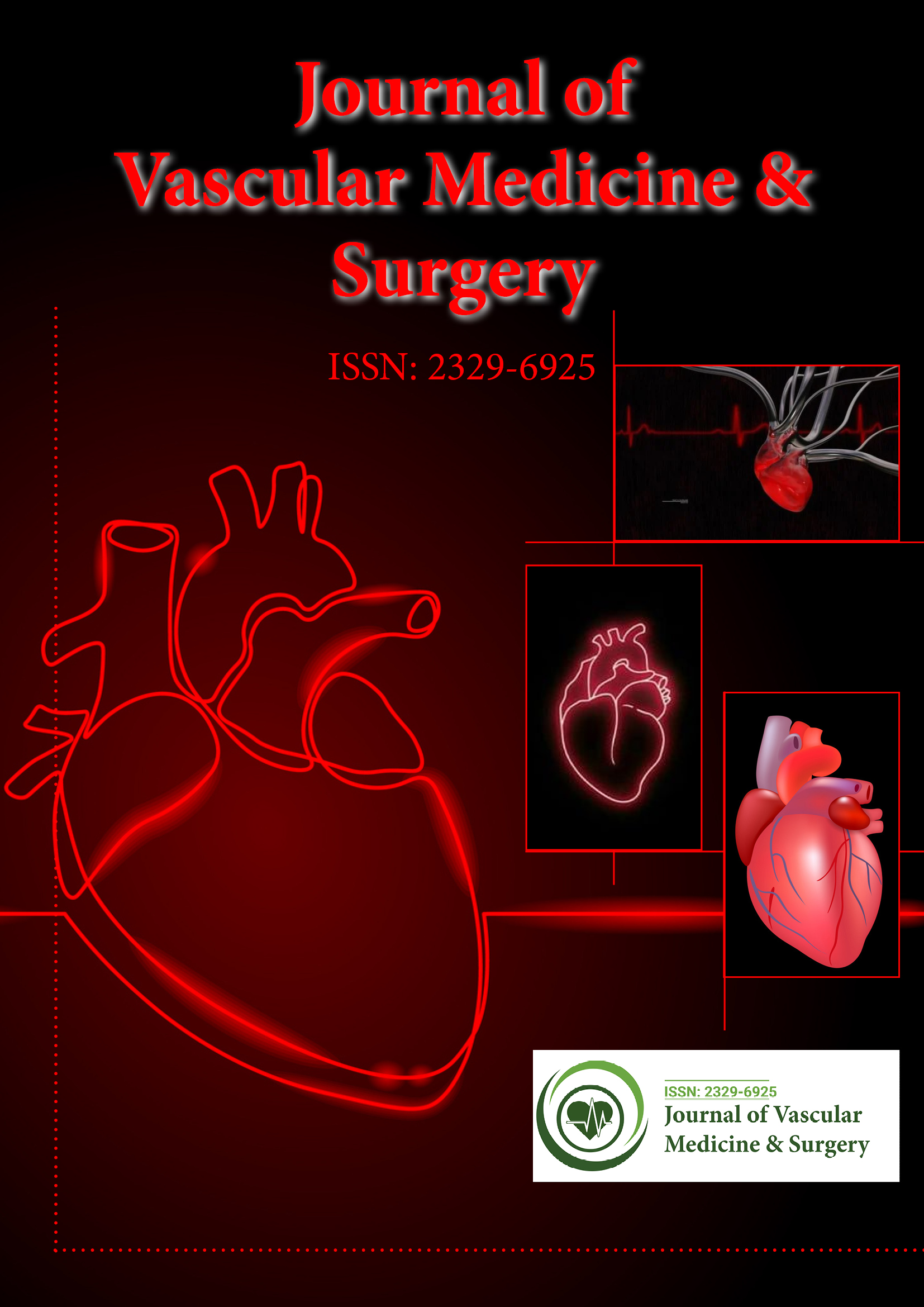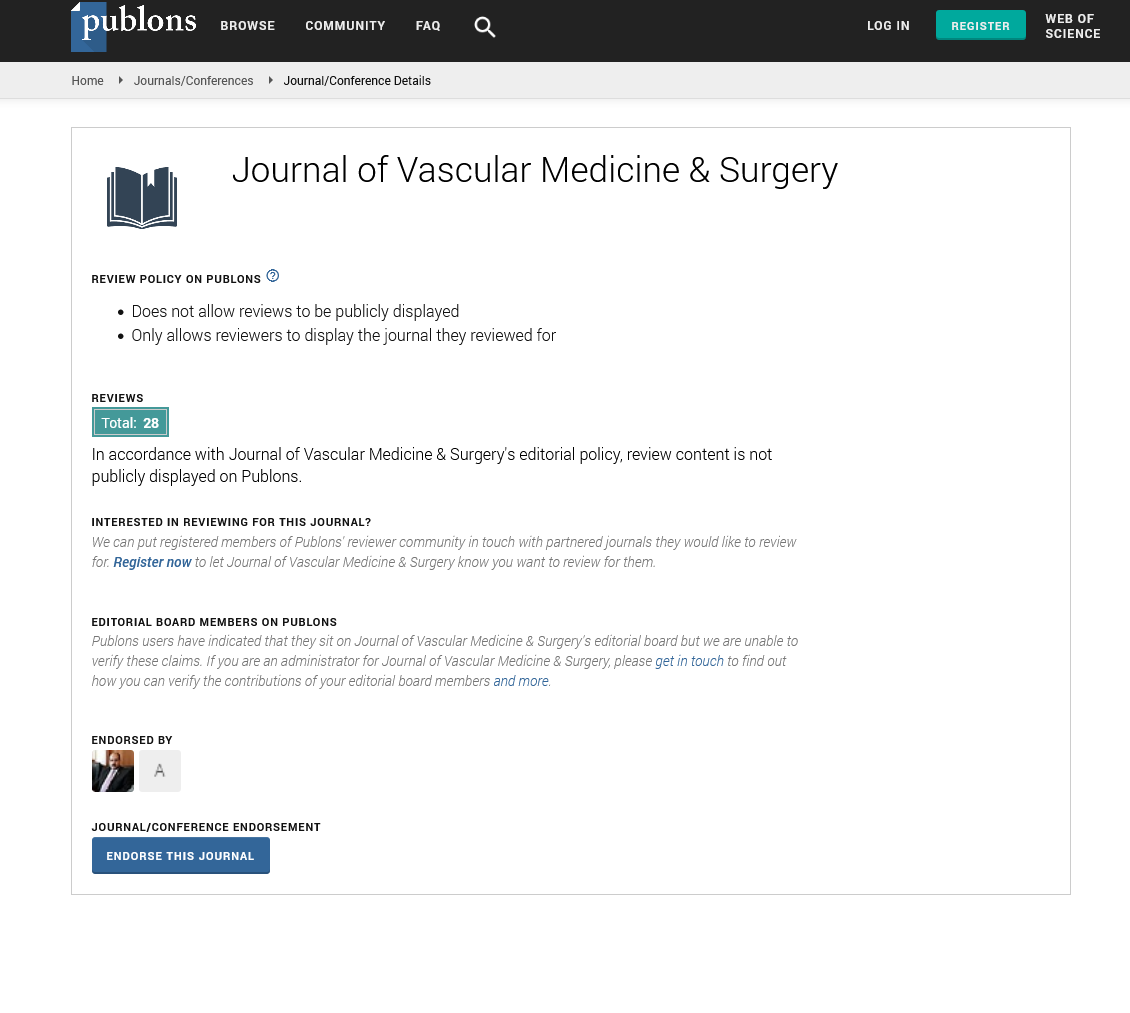Indexed In
- Open J Gate
- Academic Keys
- RefSeek
- Hamdard University
- EBSCO A-Z
- OCLC- WorldCat
- Publons
- Euro Pub
- Google Scholar
- SHERPA ROMEO
Useful Links
Share This Page
Journal Flyer

Open Access Journals
- Agri and Aquaculture
- Biochemistry
- Bioinformatics & Systems Biology
- Business & Management
- Chemistry
- Clinical Sciences
- Engineering
- Food & Nutrition
- General Science
- Genetics & Molecular Biology
- Immunology & Microbiology
- Medical Sciences
- Neuroscience & Psychology
- Nursing & Health Care
- Pharmaceutical Sciences
Opinion - (2025) Volume 13, Issue 7
Improving Patient Outcomes with Cutting-Edge Vascular Technologies
Gunner Jeffrey*Received: 16-Jun-2025 Editor assigned: 18-Jun-2025 Reviewed: 02-Jul-2025 Revised: 09-Jul-2025 Published: 16-Jul-2025, DOI: 10.35248/2329-6925.25.13.606
Description
Advancements in medical technology have dramatically transformed healthcare in the last few decades, particularly in the field of vascular medicine. Once plagued by limited treatment options and high rates of complications, vascular diseases are now being addressed with innovative tools, minimally invasive procedures, and smart devices that significantly improve patient outcomes. From diagnostic precision to faster recovery, cutting-edge vascular technologies are reshaping how clinicians diagnose, treat, and manage vascular conditions.
A paradigm shift in diagnosis and treatment
Traditionally, vascular diseases such as Peripheral Artery Disease (PAD), Deep Vein Thrombosis (DVT), and aneurysms were managed through invasive surgical interventions with substantial risk profiles. The emergence of state-of-the-art vascular technologies has changed this dynamic, allowing physicians to intervene earlier, reduce complications, and tailor treatments to individual patients with greater accuracy.
One of the most significant breakthroughs has been in imaging and diagnostic capabilities. Technologies such as Intravascular Ultrasound (IVUS), Optical Coherence Tomography (OCT), and high-resolution Computed Tomography (CT) angiography now provide real-time, detailed images of blood vessels, enabling clinicians to identify issues like plaque buildup or arterial blockages with unprecedented clarity. These technologies have not only improved diagnostic accuracy but have also empowered physicians to make more informed decisions during procedures.
The rise of endovascular therapy represents another critical leap forward. Procedures that once required open surgery, extended hospital stays, and prolonged recovery periods can now be performed through minimally invasive techniques. Tools such as drug-eluting balloons, bioresorbable stents, and atherectomy devices allow for precise interventions with significantly reduced trauma to the patient. In cases of blocked or narrowed arteries, physicians can now restore blood flow with minimal discomfort and downtime, greatly improving both short- and long-term outcomes.
Artificial Intelligence (AI) and machine learning are also beginning to influence vascular care. AI algorithms can analyze large volumes of imaging data to detect patterns or anomalies that might be missed by the human eye. This technology aids early detection of vascular disease, which is essential in preventing progression to life-threatening events like stroke or limb loss. Furthermore, predictive analytics can help identify patients at high risk of complications, allowing for proactive intervention and personalized treatment plans.
Enhancing recovery, monitoring, and quality of life
The benefits of cutting-edge vascular technologies extend well beyond the operating room. One of the most critical aspects of improving patient outcomes is ensuring that recovery is smooth, complications are minimized, and quality of life is restored as quickly and completely as possible. In this regard, wearable technology and remote patient monitoring systems are playing an increasingly important role.
Modern wearables, including smartwatches and specialized vascular monitors, can track blood pressure, heart rate, oxygen saturation, and even peripheral circulation in real time. These devices enable continuous monitoring of patients with vascular disease, alerting both patients and healthcare providers to any concerning changes. Such real-time data fosters a more dynamic and responsive model of care, moving away from episodic hospital visits to a more continuous, patient-centered approach.
Telemedicine has further enhanced follow-up care, allowing patients—especially those in remote or underserved areas—to consult vascular specialists without needing to travel. This is particularly beneficial for post-operative care, where early detection of complications such as infection or restenosis can make a crucial difference in patient outcomes. Combining telehealth with remote monitoring creates a robust safety net that keeps patients engaged and informed throughout their recovery journey.
Another area of significant advancement is in the realm of vascular grafts and synthetic materials. Innovations in biomaterials have led to the development of grafts that are more biocompatible, flexible, and resistant to infection or clotting. These improvements reduce the likelihood of graft failure or the need for repeat interventions. Furthermore, tissue-engineered blood vessels are now in development, promising to revolutionize vascular reconstruction with grafts that mimic the patient’s natural tissue and integrate seamlessly into the body.
Importantly, these technologies not only improve clinical metrics such as survival rates, healing times, and complication rates—they also have a profound impact on the overall well-being of patients. With less invasive procedures, quicker recoveries, and fewer hospitalizations, patients can return to normal activities sooner, enjoy better mobility, and maintain independence. For elderly patients or those with multiple comorbidities, this can mean the difference between prolonged institutional care and living independently at home.
Despite all these advancements, challenges remain. The cost of new technologies, disparities in access, and the need for specialized training can limit the widespread adoption of these innovations. Healthcare systems must find ways to integrate these tools equitably and sustainably to ensure that all patients—regardless of geography or socioeconomic status—can benefit from the best available care. Additionally, as more data becomes integrated into patient care through wearables and AI-driven tools, questions of privacy, data security, and ethical use must be addressed.
Conclusion
In conclusion, cutting-edge vascular technologies are not just improving how vascular diseases are treated they are fundamentally changing outcomes are possible for patients. By enhancing diagnostic accuracy, enabling less invasive treatment, supporting better recovery, and improving long-term monitoring, these innovations are setting new standards in vascular care. While challenges related to accessibility, training, and ethics still need to be resolved, the direction is clear: the future of vascular health lies in technology-driven, patientfocused care that delivers better outcomes across the board.
Citation: Jeffrey G (2025). Improving Patient Outcomes with Cutting-Edge Vascular Technologies. J Vasc Surg. 13:606.
Copyright: © 2025 Jeffrey G. This is an open-access article distributed under the terms of the Creative Commons Attribution License, which permits unrestricted use, distribution and reproduction in any medium, provided the original author and source are credited.

